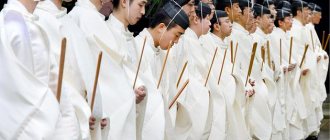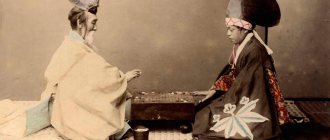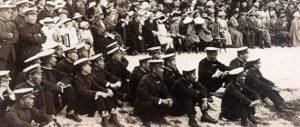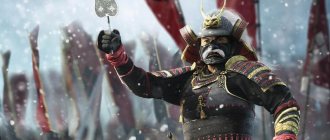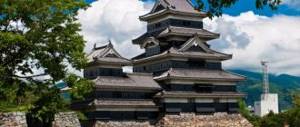Japanese mythology, which includes a lot of sacred knowledge, beliefs, and traditions of Shintoism and Buddhism, is at the same time interesting and incomprehensible to many. The pantheon contains a huge number of deities who perform their functions. There are a considerable number of demons that people believe in.
All Japanese gods list
Goddess Amaterasu . Amaterasu o-mikami - “Great goddess who illuminates the earth”, goddess of the Sun. Considered the sacred ancestor of the Japanese emperors (great-great-grandmother of the first Emperor Jimmu) and the supreme deity of Shinto. Probably originally revered as a male being, "Amateru mitama" - "Spirit shining in the sky." Myths about her are the basis of Japanese mythology, reflected in the most ancient chronicles (7th century) - “Kojiki” and “Nihon Shoki”. Its main shrine, Ise Jingu, was founded at the very beginning of the country's history in Ise Province. The High Priestess of the Amaterasu cult is always one of the emperor's daughters.
Goddess Inari . Goddess of abundance, rice and cereals in general. Often worshiped in the form of a fox. Inari is especially revered at the Fushimi Inari Taisha Shrine, as well as at his own shrines throughout Japan. Sometimes Inari is also revered in a male form, in the form of an old man.
God Raijin . God of thunder and lightning. Usually depicted surrounded by drums (taiko) and beating them. Thus he creates thunder. Sometimes he is also depicted in the form of a child or a snake. Besides thunder, Raijin is also responsible for rain.
God Susanoo-no-Mikoto . God of hurricanes, the Underworld, waters, agriculture and disease. His name translates as “Impetuous fellow.” Younger brother of the goddess Amaterasu. For a quarrel with his sister and other family members, he was exiled to Earth from the Heavenly Kingdom (which is called Takamagahara) and performed many feats here, in particular, he killed the eight-headed dragon Yamato no Orochi, and from his tail he took three symbols of imperial power - a sword Kusanagi, mirror and jasper. Then, in order to reconcile with his sister, he gave her these regalia. Subsequently he began to rule the Underground Kingdom. His main shrine is located in Izumo Province.
God Suijin . God of water. Usually depicted as a snake, eel, kappa or water spirit. Since water is considered a feminine symbol, women have always played a major role in the veneration of Suijin.
Seven gods of happiness, mystical Japan
Japan. A country of high technology, order, discipline and...ancient beliefs and traditions. Today is a story about deities - the seven gods of happiness. Their images: netsuke, engravings, street statues are found literally at every step in Japan; for many centuries, each of the Seven has been worshiped by a huge number of people.
On New Year's Eve, when all of Japan decorates their homes for happiness and good fortune, a magical treasure ship (takarabune) enters the port and lands the Shichifukujin - the seven gods of happiness - ashore. They are ready to give happiness to anyone they meet and help even with the most ordinary and everyday request. It is not so easy to meet them, because there are many who want to find happiness. The ship itself sails from a better world that lies on the other side of the sea. Takarabune - a treasure ship - is loaded with gold and rice, wisdom and longevity, health, and good luck. On the sail of the ship is the Chinese character “baku”, which denotes a mythical animal that averts nightmares.
The gods of fortune appeared in Japan, in the ancient city of Kyoto in the 14th century and they are not all local residents of Japan. The gods came from different countries: China, India and only one of them was Japanese.
The Japanese, like all people on our planet, tried to give an answer to what seemed to be such a simple, but such an insoluble question: “what is happiness.” And so, in the 17th century, the Japanese military ruler Tokugawa Ieyasu, having destroyed all his enemies, having come to the coveted power, having received everything that a mere mortal could dream of, instructed his spiritual mentor, the monk Tenkai, to “catch happiness by the tail,” namely , define this feeling. Tenkai formulated seven types of happiness: justice, material well-being, benevolent attitude, generosity, fame, long life, dignity . Each of the magnificent Seven was assigned its own role, each was assigned its own type of happiness.
Why seven? The Japanese, like much of the rest of the world, consider the number seven to be magical. In Japanese folklore, seven is a lucky number. The “seven Buddhist treasures” and the seven gods of luck are known. Japanese Buddhists believe that reincarnation occurs only seven times, and seven weeks of mourning should be observed after the death of a loved one.
In Japan, there are seven magical spring herbs that are added to rice porridge: Japanese parsley, shepherd's purse, cucumber, chickweed, chickweed, turnip, and rhizome. Spring herbs protect against diseases and expel evil from the body.
Magical autumn herbs, seven in number: Japanese clover, brisket, patrinia, Chinese sapling, cloves, sugar cane, arrowroot. These herbs are inedible and are used to decorate houses during the September full moon holiday.
Now let's take a closer look at each of the seven gods of happiness!
Ebisu. God of happiness and good luck.
He is the only one of the seven gods who is of Japanese origin. The first-born of Ebisu's parents was born without bones due to the parents' incomplete observance of the wedding ritual. At birth he was named Hirako - tadpole. Before his third birthday, Hirako was carried out to sea on a reed boat, which, after long wanderings on the waves, washed up on the shore of Hokkaido, where he was picked up by the Ainu Ebisu Saburo. Overcoming many difficulties, Hirako grew legs and arms and at the age of three turned into the god Ebisu. He is a little deaf, but cheerful and friendly, which is why he is often called the laughing god. Depicted wearing a high hat with the sacred Tai bream. It is very difficult to catch a Tai fish with your bare hands in clear heavenly water; it is also difficult to achieve peace of mind and enlightenment. At the end of March and beginning of April, these bream acquire a bright red color and go to the shores of Japan to spawn. Since cherry blossoms bloom at this time, sea bream in breeding plumage is considered the king of fish in Japan.
Ebisu was originally worshiped by fishermen and residents of fishing villages. They prayed to God for an abundance of fish in the sea and calm winds, and good luck in sailing. And to this day, fishermen set up a small shrine to him at the entrance to the bay or on the top of the cape, cut the first catch into sashimi and present it to Ebisu. Over time, this character became the deity of trade in Japan. The fish in Ebisu's hands began to be perceived as a symbolic reward for honesty in trading matters.
Ebisu was also the patron of various crafts, so netsuke carvers sometimes depicted him as a master of a certain profession, for example, a cicada catcher. In rural areas he is revered as the god of rice fields. Ebisu helps sailors in sailing, merchants in trade, and housewives in the kitchen.
The twentieth day of each month is considered Ebisu Day in Japan, and from January 9 to 11, Toka Ebisu is held - a holiday in his honor. The main event of the holiday is the ceremonial parade. A huge image of Ebisu is carried on a stretcher, followed by a motley crowd of musicians, geishas, celebrities and "luck girls" chosen from the finest beauties.
Local shops and restaurants offer special discounts at this time: since Ebisu personifies honest business dealings, merchants try to “pray” the thirst for profit by apologizing to their patron.
At Nishinomiya Shrine (Hyogo Prefecture), a special ceremony is held on the tenth day of the first moon (now January 10). The ceremony is called "Tooka Ebisu", and it begins with the ritual of opening the gates at 6 am. The first three people to appear before the Ebisu Shrine (which is 230 meters from the gate) will become “people of fortune” and will be especially blessed.
And yes, you have to fight for luck!
Daikoku (Daikoku-ten) is the patron saint of peasants, the god of wealth, brings wealth and prosperity, full bags of rice, keeper of the kitchen and giver of food.
The figurine of Daikoku is easy to recognize: good-natured, in peasant clothes, with a bag, a sacred mallet and a rat. The bag contains wealth, but the rat will only appear in a rich house: in a poor one it simply has nothing to eat. The bag itself is filled with magical rice, and when the rat gnaws holes in it, the rice spills right into your hands. Daikoku dances and taps the sacred mallet, that is, forges happiness: with each blow there is more happiness and prosperity in the world. So let him knock to his heart's content, because when Daikoku shakes his mallet, coins miraculously fall out of the air. Daikokuten is of Indian origin, but there it is a wrathful deity, guardian of faith, six-armed and three-faced. And Daikokuten reminds us of Santa Claus, with a magical wooden hammer in his hand, which allows him not only to break grains of rice, but also to work miracles. Daikoku was featured on the first Japanese one-yen banknotes, issued in 1885.
The only lady, Benzaiten. Goddess of happiness, love, beauty and art.
In Indian mythology, she was the deity of rivers (“Saraswati” means “flowing water” in Sanskrit), and is therefore associated with everything that “flows”: music, eloquence, literature. In her hands is a Japanese lute - a biwa. Benten came to Japan, just like other Indians, along with Buddhism and soon became a favorite. Near Kamakura there is the famous island of Enoshima. Legend has it that once upon a time there lived in a cave a terrible dragon that swallowed children from a nearby village.
In the 6th century, Benzaiten came to Japanese soil to protect people from a terrible monster. Hanging in a cloud above the cave, it caused a powerful earthquake. After that, she entered the dwelling of the frightened dragon and... married him. Love transformed the dragon: he became obedient and radically changed his behavior. In memory of this event, the island of Enoshima rose from the sea. It rises like an amazing rock above the surrounding sandy shallows. Here, in the middle of the sea, is the main sanctuary of the goddess.
Water always splashes next to the figure of the goddess, and you can often find a well in temples - a white snake lives there, which is a harbinger of good luck when it comes in a dream.
Although Benzaitenen symbolizes friendliness, she is also known to be a very jealous goddess. To depict jealousy, white snakes are sometimes painted that encircle the goddess. In former times, musicians who played the biwa preferred not to marry because they were afraid that the goddess would become jealous and deprive them of their ability to play.
Those families who wanted to have beautiful daughters also prayed to Benten, but the husband and wife had to read the prayers separately and never do this with each other. There was a belief that if a couple prayed to this goddess together, they would be destined to separate.
However, despite her jealousy, the goddess often showed sympathy. She is believed to have helped middle-aged, childless couples conceive as an answer to their prayers.
Nowadays, Benzaiten lovers write wishes on such signs with a love heart.
The bald monk, the cheerful Hotei-osyo is the god of abundance, the embodiment of happiness and carefreeness. It is easily recognized by its huge womb. For the peoples of the East, the belly is the refuge of the soul, and they clearly associate the fat man who came from China with spiritual breadth and generosity.
All the figurines of the Laughing Buddha, as Hotei is also commonly called, are similar to each other: a bald, short, pot-bellied man with a huge bag. In the bag, of course, there is money: silver and gold coins, precious stones and jewelry. But there is another version about the contents of the magic bag: it contains all human bitterness and sorrow. Hotei makes sure that the bag is always tightly tied, protecting people from disasters and problems.
Hotei figurines are very popular for attracting good luck and big earnings to your home. It is better to choose a golden or white figurine: the deity is capricious and has its own preferences. A cheerful god can help lonely people find a family: to do this, you need to buy a figurine in which Hotei is surrounded by children.
Activating the talisman is very simple: you just need to rub the figurine on the belly. In ancient times, the Japanese believed that if you rub Hotei’s tummy three hundred times while thinking about what you want, your wish will definitely come true!
There are many stories and legends about Hotei. One of them says that the merry fellow Hotei used to be a very handsome man and all the women who ever saw him fell in love with him. And in order not to break fragile women’s hearts, Hotei decided to become small and fat!
Another legend says that in the 10th century. The well-fed monk Qi Qi walked around the villages of China. As a wandering monk, he sometimes slept outside in the snow and blizzard, and his holiness prevented him from freezing. However, he often indulged his human weaknesses and gladly consumed meat and fish forbidden to the clergy. When passers-by asked what he was carrying in his bag over his shoulders, Qi Ci answered that he had collected all the sorrows of the world in it, and now everyone could only laugh! Where this mysterious wanderer appeared, health and good luck came to people. His jokes could make everyone laugh, rich and poor, even seriously ill people! It was believed that the monk distributed food and benefits to the poor from his never-ending bag.
Later, the mysterious contents of his bag became associated with Ta-Khun - the Great Emptiness, the progenitor of the entire surrounding world. The monk’s belly was no longer perceived simply as a symbol of the well-being and breadth of his soul, but also as an abyss in which all the suffering and sorrow of the world disappear.
Hottei is especially popular among bartenders and restaurateurs; the god of abundance inspires people to eat and drink a lot.
Fukurokuju, god of wealth, happiness and longevity. Gives wisdom, intuition, helps to make a scientific career.
His name consists of three hieroglyphs: “fuku” - happiness, “roku” - reward for work, “ju” - longevity.
Country of origin China. He can be recognized by his unusually high forehead and long white beard. In his hand he holds a staff, to which is attached a scroll with sutras. They say that this scroll contains all the wisdom of the world. Among his seven comrades, he is the only one who is able to resurrect from the dead. He lives in a palace, which is surrounded by a magical garden where the herb of immortality grows. In addition, he can do without water and without food. He loves to play chess. The following legend is connected with this: one day a farmer, returning home, saw two old men playing chess. The farmer stopped, watching the game, and it seemed to him that after each move the beards of the opponents became longer and longer. The match was long, and the bearded, long-headed old man treated the peasant to strange-tasting fruits to satisfy his hunger. A long time passed when the farmer finally noticed that the day was over and politely said goodbye to the players. Rushing home, he discovered that the house no longer existed. The stunned farmer eventually learned that 200 years had passed while he had been watching the chess game.
After living for many years, Fukuruju turned into a turtle, a symbol of immortality and the wisdom of the Universe.
Fukuroju shapeshifting figurines are very popular in Japan: when looking directly at, the human appearance of the deity is revealed, but if the figurine is placed on its stomach, a turtle appearance is revealed. His figures help to quickly make important and wise decisions, and help students remember science well!
Jurojin (“long-lived old man”) is the god of longevity and immortality. This kanji name literally translates to "Man Who Lives Long." He is considered the reincarnation of the Star God of Longevity, who monitors life on Earth and knows how long someone is allotted to live: he has a scroll, and the life spans of all creatures living on our planet are written there.
He is called the patron saint of scientists and scientific success. Jurojin is depicted with a staff made of peach wood - the Rod of Ruyi. This is a wand of wish fulfillment and happy omens. From Chinese, “ruyi” is translated as “whatever you wish.” Jurojin is dressed in a cloak and cap of a scientist and teacher. The god is bald, but has a gorgeous beard - its length symbolizes the number of years he has lived.
The god is often accompanied by a deer or turtle; according to legend, this deer is at least 1500 years old. According to legend, if you eat the meat of this deer, a person can live up to 2000 years.
Despite his advanced age, he is known as a lover of female company, and is not averse to drinking sake - after all, true wisdom cannot be achieved by avoiding fun, while always remaining serious! God also has a magical musical instrument, and when it is played, all good wishes come true, and people around become rejuvenated.
Jurojin and Fukurojin are so similar that they are sometimes considered different spirits in the body of one elder.
They say that one day Jurojin was invited to a holiday at the Emperor’s court, and there he began to boast that he could drink as much wine as he wanted. According to this Chinese legend, he then drank one koku (160 liters) of rice wine (sake), but was completely sober when he appeared before the Emperor the next morning expressing words of gratitude for a pleasant evening. He predicted a long and prosperous reign for the Emperor and then disappeared into a white fog (perhaps it was wine fumes?)
Bishamonten is the god of wealth and treasures, guardian of the North, punishes Evil, cures diseases, expels demons. Symbolizes dignity. His middle name is Tamonten - this is his name as one of the four heavenly guardians. He is strong and merciful. And in Sanskrit his name means God who hears everything.
Bishamonten is the patron saint of warriors, and therefore is dressed in military armor and holds a spear in his hand. In his other hand he holds a small pagoda. The pagoda is a treasure tower from which he gives wealth to all good people. But, on occasion, it can take your wealth back, so you must always remain good!
God Bishamon was borrowed from India, where he was the god of war or in other words, the warrior God who protected and guarded the heavens. There is a beautiful legend: more than 6 million years ago, the formidable King of the Conquerors of Evil descended from Venus to Earth, on the top of a mountain. He came down for a reason, but with a great mission to save humanity. For millions of years, his great spirit lived on the top of the mountain and ruled people's lives. And so, in 770, the monk Gantei saw a white horse on the slope of that mountain and went after it. The horse led the monk to a sacred place, where enlightenment descended on the monk and he became the reincarnation of Bishamon, the Guardian of the Northern Limits of Paradise.
In Japan, it is believed that Bishamon brings people wealth and early luck, being officially the god of wealth. The warrior god fights on the side of good, destroying evil in the world, giving happiness to everyone who asks. It is believed that if you keep the Bishamon figurine with you or in a visible place, then financial improvements will come.
His animal is a dove. Because Bishamonten is the patron saint of warriors, he is often associated with the Shinto deity Hachiman, the god of war. Tsurugaoka Hachimangu is an ancient temple where warriors asked for good luck in battle, the main shrine of Bishamon.
Since then, a huge number of pigeons have lived near the temple complex.
And today we can see flocks of pigeons on the roofs of temple buildings, and the Tsurugaoka Hachimangu complex itself is the main purpose of pilgrimage to these lands.
In the 14th century the cult of the seven gods reached its peak. This was especially true in the capital of Japan, Edo, where there was a custom of annual pilgrimage to temples dedicated to one or another god of happiness. This pilgrimage took place in the first month of every year. And now those who urgently need divine support or who want to escape from the daily whirlwind and, under the shadow of sacred temples, indulge in unhurried thoughts about the eternal, go on a small journey - a pilgrimage to temples associated with the gods of luck. The temples are located close to each other so that believers can visit all seven temples in one night. There are several such “ring routes” in Tokyo. The most popular of them runs along the banks of the Sumida River and is approximately three kilometers long. There are signs along the entire path, so it is difficult even for a stranger to lose his way. You can go the whole way alone, but there is also the opportunity to join a group of pilgrims. In each of the temples, a visitor can put a colorful stamp on a specially purchased card, which thus itself becomes a talisman and a “guarantee” that luck will not abandon its owner. Pilgrims buy small figurines of the seven gods in the temples - separately or all together on a small treasure ship - Takarabune. After all, it is loaded not only with gold and rice, but also with wisdom, longevity, health, and good luck.
Most often, temple visitors buy the ship depicted in the engraving.
This drawing should be placed under your pillow on New Year's Eve. The Japanese are confident that the first dream in the New Year is prophetic and determines fate for the whole year. It is best if in a dream you see Mount Fuji, hawks or... eggplants.
Noble Mount Fuji, a smart and strong bird, but an eggplant? This came from a statement by Shogun Tokugawa: when he learned about the cost of the first eggplants of the season, he was very surprised and said that only Mount Fuji and Mount Ashitaka (“taka” - hawk) were more expensive (higher) in his province. It is also said that Mount Fuji, falconry and the first eggplant of the season were the shogun's favorite things. So a dream about an eggplant is perceived as a clear forecast of a happy year.
Those who are unlucky with their dreams, who dream of something unpleasant, can get rid of the obsession by throwing a leaf with the image of Takarabune into a stream or river in the morning. Then a bad dream - a harbinger of bad luck - will be carried away by the waves far out to sea.
All Japanese spirits and demons list
Abumi-guchi . Also Known As: Abumi-kuti This furry little creature begins its life as a small loop that is used to attach the stirrups of warlords. When a man died in battle, the stirrup could sometimes be forgotten on the battlefield, and then the abumi-guchi would appear, the old stirrup becoming his mouth, and the ropes coming from the saddle turning into his limbs. It is believed that abumi-guti will wait alone, like a faithful dog, for his master, who will never return.
Ao-sagi-bi . Also known as: Ao-sagi-no-bi Sometimes, on dark nights, one could see an amazing heron, with flaming eyes, and white feathers surrounded by an unnatural glow. From a distance, the bird looked like a small ball of fire. Could a heron be among the animals endowed with magical powers?
Asi-magari . On the island of Shikoku, strange occurrences were often attributed to the antics of raccoon dogs, and the nighttime phenomenon in Kagawa Prefecture was no exception. Like sune-kosuri, ashi-magari wraps itself around the legs of a person walking in the darkness, and as a result he cannot move. Those who bent down and tried to find out what was bothering them described that it felt like soft, damp cotton, and when squeezed, it was very similar to the tail of some kind of animal.
Asuras .
Eternally warring demons inhabit one of the Buddhist worlds - Shura-Kai. They are reborn as those who desire power and superiority over others. Initially, asuras (singular number - asura) are demons of Indian folklore who rebelled against the will of the gods. They are depicted as powerful multi-armed demon warriors.
Origins
The mythological Far Eastern system is known from the “Records of Ancient Acts” (“Kojiki”), compiled by order of the ruling Yamato clan, dated 712, and the “Annals of Japan”, which came from 720. The most significant ancient collection, the Kojiki, includes 3 scrolls, of which the first is dedicated to oral traditions passed down from generation to generation (Takamagahara), and the other two are dedicated to the actions of divine children. These events reflect the history of the Land of the Rising Sun. The second scroll is dedicated to the events of Izumo (the prototype of the region is Shimane), the third tells about Tsukushi (Kyushu), where the god Ninigi ruled. The Kojiki is unique - it is the main Shinto holy book of the three main ones, as well as a key ancient Japanese literary monument.
Many ancient myths are given in the collection "Man'yeshu" compiled in the 8th century, in the "Engi Shiki", which lists traditional songs performed at court in the 10th century.
All the sacred knowledge of the inhabitants of the Land of the Rising Sun is unusual, unique, and unlike that common in other lands. They represent people as divine descendants, include the foundation of Shintoism and reflect the mentality, spirituality, and psychology of the Japanese that have developed since ancient times.
In mythology, people are descendants of gods
Influence of religion
Heroes, gods, and creatures known from Japanese mythology reflect the main ancient religion of the population of the archipelago - Shintoism. The essence of the direction is the veneration of many sacred kami. The teaching is closely related to Buddhism, the way of Tao and the ideas of Confucius. The peculiarity of Shintoism is the absence of strict dogmas and written canons. The way of Shinto includes the philosophy of folk beliefs and legends reflected in the Kojiki and Nihon Seki. It was formed under the influence of the provisions of “Fudoki” (a work on folk customs and Japanese lands), the decrees of semme, mentioned in a number of chronicles, and the codes that governed the ceremonies.
Shintoism as a religious reflection of the history of the Land of the Rising Sun is a mythological justification for the power of the emperor, who was revered as a divine descendant, the heir of Amaterasu. Ancient myths tell about the struggle of Yamato traditions with local foundations and codes, which ended in the unconditional victory of the rules of the ruling dynasty.
From encyclopedias of myths and religious tales of ancient Japan, it is known that it is Shintoism, Buddhism and folk beliefs that are the source of the polymorphism that characterizes the country today. The structure of society and the family is subordinated to Confucian ideas, the path of Tao determines the connection between man and nature, Buddhism talks about the role of the individual in the state, and Shintoism, formed on the basis of ancient myths, determines the place of the individual in the world.
Since the 13th century, the Land of the Rising Sun has been the site of the development of local cults of ancestor gods. At the same time, Shintoism is being revised without connection with Buddhism, and the “Fivefold Scripture of the Way of the Gods” is being distributed. The ancient teaching is presented as superior to that created by ordinary people (for example, Confucius).
The Way of Shinto is based on ancient myths
Goddess in anime
Amaterasu appears in the anime and manga:
- Homeless God;
- Amino amino;
- A magical unit of paladins and summoned demons;
- Goddess of failure.
Amaterasu appears in the popular anime Naruto - a fighting technique is named after her.
Shinigami
Like Amaterasu, Shinigami are kami known from Shintoism. They can be called guides of souls. Both Amaterasu and Shinigami appear in the manga and anime D.Gray-man.
D.Gray-man
Shintoism - the way of the gods
It is necessary to briefly say about the traditions that gave birth to the pantheon of Japanese gods. The first of these, of course, is Shinto, which means “the way of the gods.” Its history goes back so far into history that today it is impossible to unambiguously establish either the time or the nature of its occurrence. The only thing that can be stated with absolute certainty is that Shintoism originated and developed on the territory of Japan, remaining an untouchable and original tradition, until the Buddhist expansion, which did not experience any influence. The mythology of Shintoism is very peculiar, the cult is unique, and the worldview is quite difficult for deep understanding.
In general, Shintoism is focused on the veneration of kami - the soul or some spiritual essence of various creatures, natural phenomena, places and inanimate (in the European sense) things. Kami can be evil or benevolent, more or less powerful. The patron spirits of a clan or city are also kami. In this, as well as the veneration of the spirits of ancestors, Shintoism is similar to traditional animism and shamanism, inherent in almost all cultures and pagan religions at a certain stage of formation. Kami are Japanese gods. Their names are often quite complex, and sometimes extremely lengthy - up to several lines of text.
God of destructive fire
Kagutsuchi, the god of fire, was also the child of the divine couple. He burned his own mother with his fiery essence. His father Izanagi became angry. He could not bear the death of his wife and wife, so he cut off the head of the son who killed his mother. Blood flooded the earth and gave birth to even more spirits, among whom were the thunder gods, mountain gods and the dragon god. The Japanese considered Kagutsuchi the progenitor of many powerful gods who created iron and weapons. The god of fire was the destroyer of buildings, especially wooden ones. There are many religious rituals associated with it that pacify it.
Weather Gods
Raijin and Fujin are gods of the natural elements. Raijin controlled lightning and brought down storms on mortals. He beat his drums with a giant hammer. Raijin is depicted with three fingers, symbolizing the past, present and future. Fujin is the master of the winds, which he carries in a bag over his shoulders. Fujin is the savior of Japan from the Mongol invasion, sending the divine kamikaze wind to them. You can often hear about him in myths about samurai. Fujin comes from the god of war, Hachiman.
Influence of Buddhism on Shintoism
From the middle of the first millennium, and especially from the 9th century, Shintoism began to experience the strong influence of Buddhism. This led to the kami initially becoming the protective spirits of Buddhism. Some of them merged with Buddhist saints, and later the teaching was proclaimed that the kami even needed salvation through the path of Buddhist practice. For Shintoism, these are unconventional ideas - from time immemorial there was no concept of salvation or sin in it. There was not even an objective representation of good and evil. Serving the kami, the gods, led the world to harmony, to beauty, to the consciousness and development of man, who himself, inspired by the connection with the deities, decided what was good and what was bad in each specific situation. The internal inconsistency of the two traditions led to the fact that quite early movements appeared to cleanse Shinto from Buddhist borrowings. Attempts to reconstruct the original tradition ended with the so-called restoration of Emperor Meiji in the 19th century, who separated Buddhism and Shintoism.
The Myth of the Young Fisherman
Another famous mythological hero of Japan is the young fisherman Urashimo Taro. One day, a young man saved a huge sea turtle from death, who admitted that he was the daughter of a sea ruler. As a reward, she took the fisherman with her to her father's palace at the bottom of the sea. After staying as a guest for several days, Urashimo asked to go home. Then the princess gave him a small box and ordered him never to open it.
But once on land, the fisherman learned that more than seven hundred years had passed since his absence. In horror, he opened the gift, gray smoke came out, which instantly aged the young man and he died.
Fishermen and sailors believed that seeing a gray haze over the expanse of the sea was not good: it could make you seriously ill and die before your scheduled time.
Main deities
A special feature of the belief system of the peoples of the eastern archipelago is the diversity of mythical creatures. Sometimes a country has a state of eight million gods. Because the names of magical creatures are long, established abbreviations have emerged. The five supreme beings are especially revered. First, the trio of Hitorigami appeared - Ame no Minakanushi, Takamimusuhi, Kamimusuhi. They were later joined by Umashi Ashikabi Hikoi, Ame no Tokotachi. The first five were expanded by Kamienanae - seven tribes, which included the creators of the Izanagi archipelago, Izanami. They gave birth to Oyashima - the 8 largest islands of the Land of the Rising Sun.
A special place in the Japanese pantheon is occupied by the Sea and the night and daylight. They appeared when Izanagi was undergoing purification in the underworld. From the left eye of the god came the Sun Goddess, from the right - the Moon Tsukuyomi, from the nose came the sea lord Susanoo. Izanagi determined how the world would belong to the new deities. He named Amaterasu the head of the pantheon, entrusted time to the moon god, and Susanoo - the expanses of water and the elements.
Originally there were 5 gods
Patroness of the Nation
The Goddess Guanyin is of great importance not only in China, but also in South Korea, and also, of course, in Japan. Here she received the name Kannon and is considered a companion of Buddha Amitabha. Behind the scenes, she is called the Buddhist Madonna.
She is usually represented in the guise of a woman, and therefore she primarily patronizes the female half of humanity. Although, being an important goddess who personifies mercy, she becomes the protector of the entire nation.
Goddess Kannon
There is an interesting legend associated with it. Once upon a time, Guanyin Bodhisattva wanted to go to heaven, but right before the gate she heard human groans and screams - then she realized that she was called to help people, to protect them from illnesses and adversities. People involved in maritime affairs, crafts and trade most often turn to her.
She is able to give women long-awaited offspring. The image of Kannon, depicted in sculptures, can be found everywhere: in temple complexes and their gardens, home altars and at shrines near roads. Most often, she appears as many-eyed and many-armed - this shows that she sees in all corners of the world and tries to help everyone who asks her for it.
Other important creatures
The mythology of Japan is the subject of much discussion, and the number of characters can number in the hundreds. Let's talk about other, most popular heroes of myths and legends.
- Tanuki are funny badgers or raccoon dogs that can bring happiness. They make fun of people, love to drink sake, and their scrotum can become so incredibly large that sometimes the tanuki himself takes refuge under it. It is believed that the larger it is, the greater happiness there will be.
Japanese Tanuki Raccoon
- Kitsune is a one-, five-, or nine-tailed fox with silver fur that can turn into a human and even start families with people. They can be either attached to people and kind towards them, or evil.
Werefox Kitsune
- Kirin is a Japanese divine dragon. Unlike his Chinese brother Qi-Lin, he has not 5 toes on each foot, but 3.
Dragon Kirin
- God Yato, whose real name is Yaboku, is a relatively modern character, best known from the fantasy manga work The Homeless God. This is a deity of death who was almost forgotten and who has no sanctuary.
"Homeless God" Yaboku
- Tengu is a humanoid creature with a red face, an angry expression and a large, long nose. Its body is enormous in size and sometimes has wings. Tengu is very strong and skilled in battle.
Tengu
- Ayakashi is a snake that lives in ponds and seas and reaches a length of 2 kilometers.
Sea Serpent Ayakashi
- Bake-neko - a cat -
a werewolf, a demon, capable of possessing people. They are distinguished by several tails. Therefore, many kittens used to have their tails docked so that they would not split in two, and after the death of the owner, the cat would be closed so that the soul would not move into them.
Bake-neko cat
